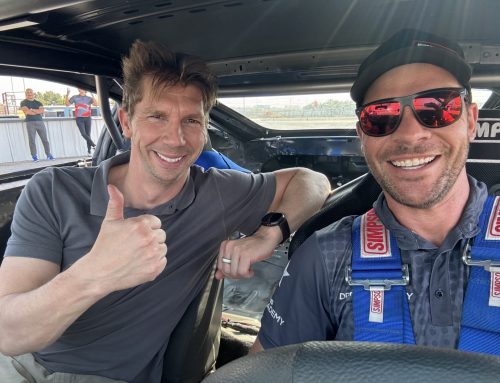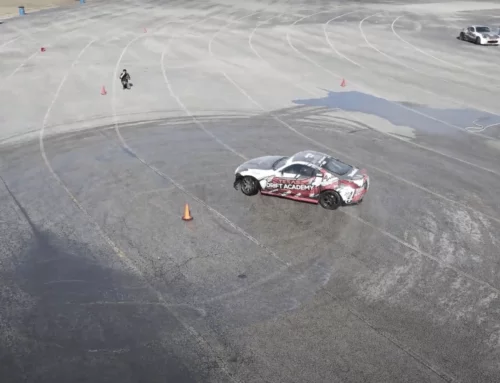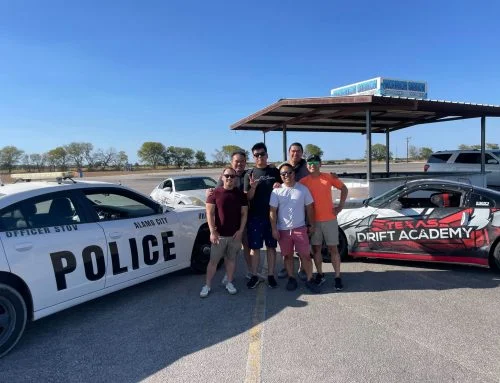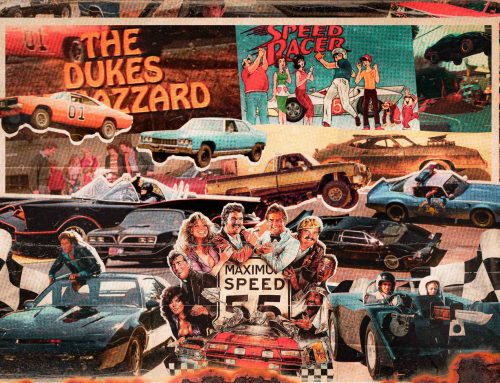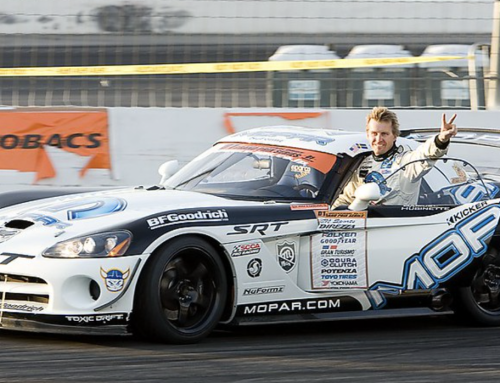Weight transfer. Throttle finesse. Feel grip. Oversteer. Countersteer. Control. Speed.
These things are not just related to drifting. These are about car control. Drifting teaches valuable skills, habits and muscle-memory that help drivers progress in multiple motorsports. And, helps avoid accidents in daily driving!
To elaborate on these points, with an engineering-type explanation, we interviewed Dave Ogburn, a TX-based accomplished race car driver AND a professional test driver for Goodyear tires for the last 13 years.
Who is Dave Ogburn?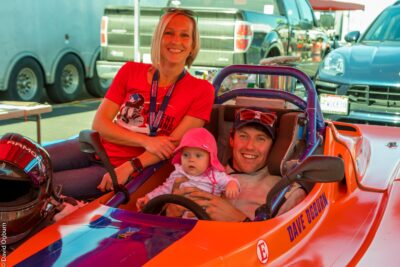
- Resides in San Angelo, Texas, originally from Richmond, VA.
- Initiated racing in high school and took part in Baja SAE in college.
- Graduated with a Mechanical Engineering degree from the University of Virginia in 2008.
- Worked for Honda R&D and was introduced to kart racing at Circleville Raceway in Ohio.
- Performance test driver for Goodyear since 2010, with training in various car evaluations and participated in One Lap of America in a 2018 Camaro ZL1 1LE.
- Races a Spec Racer Ford with SCCA since 2017, previously started with a touring car in 2016.
- Secured 21 race victories and achieved 2nd place in the SCCA National Championship Runoffs in Spec Racer Ford.
- Before road racing, participated in shifter kart racing and autocross – won two SCCA Solo National Championships in 2011 and 2015.
- Before road racing, participated in shifter karts and won two SCCA Solo National Championships in 2011 and 2015.
- Engaged in endurance racing with the World Racing League, racing a Toyota 86 in the GP3 class.
- Established driver coach mainly for SCCA club racing and vintage racing.
What do you drive? Where do you race? Anything else about your profile/career to share?
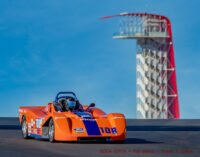 I currently race a Spec Racer Ford with the SCCA. It’s an open cockpit sports racer that is heavily controlled for parity (sealed engine and sequential SADEV gearbox) with a spec chassis, dampers, and tires. I started road racing with the SCCA in 2016 with a touring car and then moved to the Spec Racer Ford in 2017 for the tighter racing and close, tough competition. I’ve won about 20 races and have a best finish of 2nd place in the SCCA National Championship Runoffs in the Spec Racer Ford. Before road racing, I raced shifter karts for a few years and auto crossed with the SCCA winning two SCCA Solo National Championships (2011 and 2015). I also compete in endurance racing in the World Racing League with a team of four top Spec Racer Ford drivers. We race a Toyota 86 in the GP3 class. Additionally, I work as a driver coach in mainly SCCA club racing and vintage racing – most of my clients and work is in and around Texas, but I am open to any racetrack anywhere!
I currently race a Spec Racer Ford with the SCCA. It’s an open cockpit sports racer that is heavily controlled for parity (sealed engine and sequential SADEV gearbox) with a spec chassis, dampers, and tires. I started road racing with the SCCA in 2016 with a touring car and then moved to the Spec Racer Ford in 2017 for the tighter racing and close, tough competition. I’ve won about 20 races and have a best finish of 2nd place in the SCCA National Championship Runoffs in the Spec Racer Ford. Before road racing, I raced shifter karts for a few years and auto crossed with the SCCA winning two SCCA Solo National Championships (2011 and 2015). I also compete in endurance racing in the World Racing League with a team of four top Spec Racer Ford drivers. We race a Toyota 86 in the GP3 class. Additionally, I work as a driver coach in mainly SCCA club racing and vintage racing – most of my clients and work is in and around Texas, but I am open to any racetrack anywhere!
I’ve been super lucky with driver training, testing, and racing opportunities through my job with Goodyear as a performance test driver. I started with Goodyear in 2010 and worked for Goodyear since 2010 and have been trained as a subjective evaluator by Goodyear’s most experienced test drivers. My core training was 2010 through 2012, but we get to continually develop our skills through ride and handling testing, off-road testing, snow/ice testing, and track testing on road courses like VIR, Road Atlanta, Nelson Ledges, and Nurburgring. As part of Team Goodyear, I competed in the last two One Lap of America events in a 2018 Camaro ZL1 1LE that is one of our test cars in between competitions.
When in your career did you get drifting training and how did you get trained?
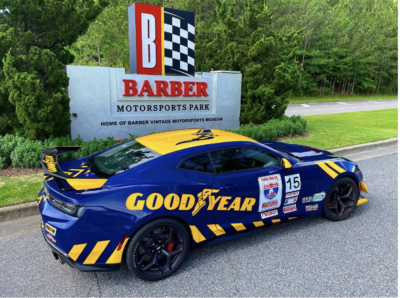 Starting in 2010 with Goodyear, I was trained in basic drifting skills (weight transfer, how to initiate, controlling a slide, throttle maintenance) as a general effort to improve my car control and comfort level at the limit. Part of my job is to subjectively evaluate tires at and above the limit so the driving portion of the test maneuvers and slide recovery has to be subconscious so at least a few brain cells are left over to think about what the tire is doing. For Goodyear, we also do demo rides for customers and visitors to the proving grounds so there is an expectation that we can hop in any of our test cars (BMW 3-series, Mustangs, Corvettes, Camaro’s) and give a fun, slidey lap on command. My training started with basic circles (ie can you drift a full circle) starting with a clutch kick or just applying throttle. We then moved to using weight transfer (feint, scandi flick) or a handbrake to initiate and control a drift around one of the 9 corners on our small road course at the proving grounds. I’ve now have given 5,000 drift laps around this track. I’ve never competed in drifting or driven a properly prepared drift car, but I still push to get more angle, more smoke, and more smiles on these demo rides. I’ve also used skid cars at some Goodyear-sponsored driving schools as well which are a great tool develop comfort sliding a car and understand weight transfer.
Starting in 2010 with Goodyear, I was trained in basic drifting skills (weight transfer, how to initiate, controlling a slide, throttle maintenance) as a general effort to improve my car control and comfort level at the limit. Part of my job is to subjectively evaluate tires at and above the limit so the driving portion of the test maneuvers and slide recovery has to be subconscious so at least a few brain cells are left over to think about what the tire is doing. For Goodyear, we also do demo rides for customers and visitors to the proving grounds so there is an expectation that we can hop in any of our test cars (BMW 3-series, Mustangs, Corvettes, Camaro’s) and give a fun, slidey lap on command. My training started with basic circles (ie can you drift a full circle) starting with a clutch kick or just applying throttle. We then moved to using weight transfer (feint, scandi flick) or a handbrake to initiate and control a drift around one of the 9 corners on our small road course at the proving grounds. I’ve now have given 5,000 drift laps around this track. I’ve never competed in drifting or driven a properly prepared drift car, but I still push to get more angle, more smoke, and more smiles on these demo rides. I’ve also used skid cars at some Goodyear-sponsored driving schools as well which are a great tool develop comfort sliding a car and understand weight transfer.
Can you share specific drifting techniques or skills that have directly translated to improved performance in traditional racing?
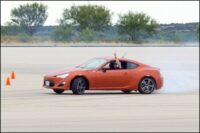 Weight transfer control and a feel of the limit of your tires (which can change every lap) are king in road racing. It’s one thing to learn how to trail brake and use a throttle lift to point the nose of a race car in a medium speed corner, but I think it helps to learn all extreme ends of weight transfer to really feel the power of weight transfer. Practicing drifting gives you those extremes. Instead of trying to get a small rotation in the car, you are trying to initiate a huge oversteer angle and then have to learn how to keep this angle through the corner. If you are trying to learn how to use a small release of the brake to help rotate a race car on corner entry, I think it helps to learn how a well-timed flick of the steering wheel combined with a rub of the brake can initiate oversteer.
Weight transfer control and a feel of the limit of your tires (which can change every lap) are king in road racing. It’s one thing to learn how to trail brake and use a throttle lift to point the nose of a race car in a medium speed corner, but I think it helps to learn all extreme ends of weight transfer to really feel the power of weight transfer. Practicing drifting gives you those extremes. Instead of trying to get a small rotation in the car, you are trying to initiate a huge oversteer angle and then have to learn how to keep this angle through the corner. If you are trying to learn how to use a small release of the brake to help rotate a race car on corner entry, I think it helps to learn how a well-timed flick of the steering wheel combined with a rub of the brake can initiate oversteer.
Drifting also helps to build other useful skills like recovery of a slide and throttle control. Every drift requires a different rate and amplitude of the steering correction whether you are trying to gather up an oversteering racecar or maintain a slide in a drift car. We’ve all seen a road racer overcorrect and then shoot into the grass on the opposite side of the track. Drifting helps build comfort and confidence in not firing in a correction so quickly and abruptly that it causes you more issues. You can’t build these skills by reading a book or watching a video, you need butt-in-seat time controlling different cars, yaw rates, and amplitudes so you can subconsciously control a slide on track with one correction and no overcorrection. You need the muscle memory and practices drifting hones these muscles.
In what ways has drifting helped you become more comfortable with car control and handling at the limit of grip?
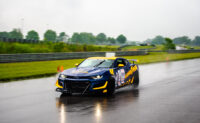 I’ve always wondered how people who have only road raced have confidence driving a car at the limit through faster corners. I learned car control through autocross and low/medium speed drifting so by the time I road raced, I had the confidence to put a car on its limit knowing that I could correct almost any slide. Confidence in your car control is extremely important in pushing to the limit in a road race car! As you get closer to the limit in road racing, the slides can happen suddenly but tires always give you a bit of warning that bad things are about to happen. Purposefully practicing drifting gives you experience what a tire feels like when it’s getting too hot, is about to breakaway, and snaps into oversteer.
I’ve always wondered how people who have only road raced have confidence driving a car at the limit through faster corners. I learned car control through autocross and low/medium speed drifting so by the time I road raced, I had the confidence to put a car on its limit knowing that I could correct almost any slide. Confidence in your car control is extremely important in pushing to the limit in a road race car! As you get closer to the limit in road racing, the slides can happen suddenly but tires always give you a bit of warning that bad things are about to happen. Purposefully practicing drifting gives you experience what a tire feels like when it’s getting too hot, is about to breakaway, and snaps into oversteer.
Have you found that drifting has enhanced your ability to recover from oversteer situations while racing? If so, how?
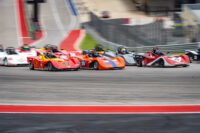 Yes, immensely. It helps to hone the rate and amplitude of the steering correction and how you balance the car on the pedals while correcting to get the oversteer to return without overshooting to an faster snap oversteer in the opposite direction. Also, the experience of drifting means I don’t panic when the race car oversteers – I know what to do subconsciously from feeling the rate and amount of oversteer which drives how quickly I correct. Panic leads to corrections that are too fast and abrupt. With corrections that aren’t rushed, you also better keep up your momentum and lose less lap time despite the unplanned oversteer.
Yes, immensely. It helps to hone the rate and amplitude of the steering correction and how you balance the car on the pedals while correcting to get the oversteer to return without overshooting to an faster snap oversteer in the opposite direction. Also, the experience of drifting means I don’t panic when the race car oversteers – I know what to do subconsciously from feeling the rate and amount of oversteer which drives how quickly I correct. Panic leads to corrections that are too fast and abrupt. With corrections that aren’t rushed, you also better keep up your momentum and lose less lap time despite the unplanned oversteer.
How did drifting affect your understanding of weight transfer and vehicle dynamics, and how does this knowledge benefit you in racing?
By creating the extreme amount of oversteer you WANT to create in drifting vs. the rotation you want when road racing, you learn how to play with the rate/amount of pedal application and how you time it with the steering input to create different rates and amounts of oversteer on your drift. If you learn how to over-rotate a car during drifting, it can help you learn how to properly rotate the car in road racing.
Can you describe any mental or psychological benefits you’ve gained from drifting, such as increased confidence or reduced fear when pushing the car to its limits?
Both of those – increased confidence to control my racecar in wet and dry racing conditions which leads to less fear and more of an ability to push especially on cold tires and in the wet when oversteer can be its snappiest.
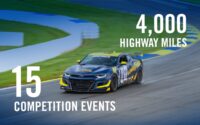 What advice would you give to race car drivers looking to incorporate drifting into their training regimen to become better drivers overall?
What advice would you give to race car drivers looking to incorporate drifting into their training regimen to become better drivers overall?
Take a school, get instruction, and learn in a safe and controlled environment. You need to have a safe, low(ish) speed environment to make mistakes, spin the car, and over-correct without dire consequences. By having this freeing environment to play with the car and your inputs, you learn how to feel the yaw rate, feel the tires, hear the tires, and then use this feedback to give the inputs to the pedal and steering that control oversteer. It is something that can’t be taught in a book or video – you have to learn to FEEL the car and tires while sliding.
In what ways has learning car control through drifting influenced your driving style and decision-making on the track?
It has helped me to build confidence to push on cold tires and to the limit of my race car more quickly vs. slowly building up to the limit because I am confident in my ability to control the car should things go sideways. When tires are cold and are coming up to temp, you can get more sudden and unexpected oversteer. It makes it more challenging, but it can be a big advantage to build a gap or make passes in the opening laps of the race or means you can get to your maximum qualifying pace more quickly in a session which is an advantage if there is an early yellow flag or incident that shortens a session.
Have you observed any specific benefits from drifting in terms of race strategy or the ability to adapt to different racing conditions?
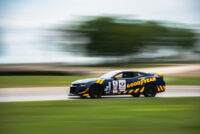 It goes back to confidence – drift and car control training makes me more able to handle different grip levels (as the track changes, rain, tires going away, etc.). This confidence also helps you push to the limit more quickly in new racecars. If you want to be a pro racing driver or driver coach, one skill you need is the ability to get up to speed quickly in an unfamiliar car. The car control and feel you gain from drifting practice is one piece of this skillset.
It goes back to confidence – drift and car control training makes me more able to handle different grip levels (as the track changes, rain, tires going away, etc.). This confidence also helps you push to the limit more quickly in new racecars. If you want to be a pro racing driver or driver coach, one skill you need is the ability to get up to speed quickly in an unfamiliar car. The car control and feel you gain from drifting practice is one piece of this skillset.
Can you share any anecdotes about moments in racing where your drifting skills played a critical role in avoiding accidents or maintaining control?
I was racing at Road America in 2020 at the SCCA June Sprints. We had a pack of about 70 Spec Racer Fords. Coming up the hill at the blind turn 13, I grabbed too much curb with the left front and it spiked by car into the fastest snap oversteer I’ve experienced on track. I put in about 180 degrees of countersteer with the fastest rate I could muster (no power steering) – this killed the rotation, the car paused for a microsecond with about 45 degrees of yaw, and then came back to me. It all happened in a moment and the correction was purely subconscious. I was running 5th at the same time in the opening laps with 60+ cars behind me. If I had spun, it could have been a massive accident and my car would likely have been totaled after getting hit by multiple other racecars bearing down on me. Without years of car control training, my day goes very differently.
What are some key takeaways from your drifting experience that you believe every race car driver should be aware of?
- How weight transfer can be used to keep a road race car on the limit and also initiate a drift – same skill, different application
- The rate and amplitude of your steering correction is key to smoothly driving truly on the limit in a road racing car – drifting can help you hone this skill
- The more resolution you have in the way you apply the throttle, the faster you can be in a road racing car (especially one with high horsepower) and this skill can be honed and practiced balancing a car in a nice, smokey drift.
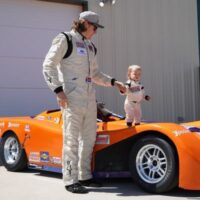 How has your passion for drifting enriched your overall racing experience, and what would you say to others who might be hesitant to explore this crossover?
How has your passion for drifting enriched your overall racing experience, and what would you say to others who might be hesitant to explore this crossover?
If you are uncomfortable to explore drifting, lean into it and conquer the fear, and it will make you safer and faster on track. It takes real skill to drift a car and if you can control a drift car, you are infinitely more likely to be able to gather up any oversteer you have on track.

